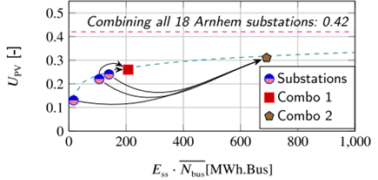Solar PV systems have recently become the option for the sustainable supply of urban electric transport networks such as trams and trolleybus grids.
However, no consensus exists yet on the placement or size of PV systems at the traction substations, and no method is available for easy estimation of the PV system utilization performance. The latter is crucial for understanding the need for storage, grid exchange, or even power curtailment, and has therefore a direct impact on the technical and financial feasibility of the project.
The paper by Diab et al. looks at 11 Key Performance Indicators (KPI) that are easily available to trolleybus operators, in two PV case studies of Arnhem (NL) and Gdynia (PL), using verified and validated bus, grid, and PV models.
Through one KPI defined by the authors called Energy-Traffic KPI, a strong trend (𝑅2=0.93) is described that can now allow stakeholders for a quick estimation of the PV plant potential using a simple third-degree polynomial instead of resorting to the complex grid, bus, and PV modelling. A simple placement and sizing method is also presented derived from this KPI, in a way as to increase the technical and economic feasibility of an installed PV system.
The tool works for a single traction substation as well as for a combination of multiple substations.
A key outcome is the presence of an intrinsic, upper-performance plateau that exists in transport grids, at around 38% direct PV utilization, caused by the unavoidable mismatch between PV generation and vehicle timetables and schedules. This means that over 62% of the PV energy will be wasted or stored, both of which have significant financial impact on the project. This can only be solved by the creation of a base load such as by the connection of electric car chargers or residential loads.
